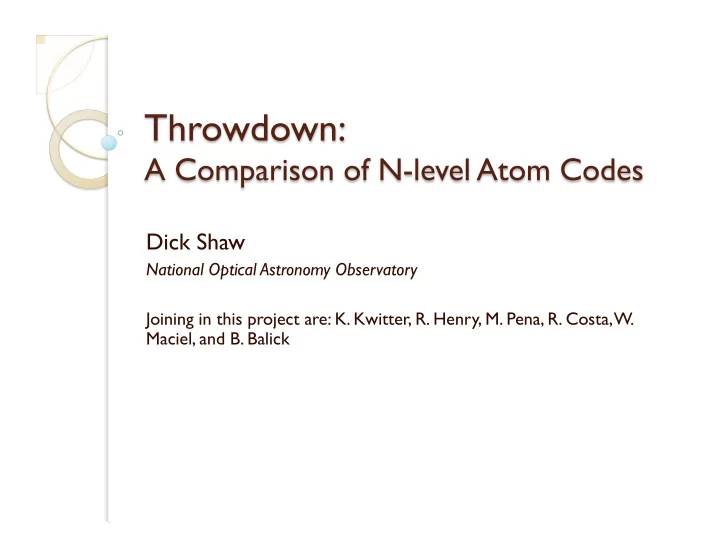

Dick Shaw National Optical Astronomy Observatory Joining in this project are: K. Kwitter, R. Henry, M. Pena, R. Costa, W. Maciel, and B. Balick
A modest number of 5-level atom codes have been developed over the past few decades, more or less independently, that compute level populations & volume emissivities for low-lying levels of common ions. This permits the derivation of T e , N e , and ionic abundances for collisionally excited species. Lately the developers of nebular and ELSA have begun a detailed comparison: To verify correct functionality To compare feature sets To develop regression test suites To identify issues with the input atomic data October 27, 2010 2
Nebular * is a package within IRAF/STSDAS Heritage is FIVEL program of De Robertis, Dufour & Hunt (1987) Is an N-level atom “toolbox” for analyzing CELs in ~3 dozen ions Computes T e , N e for a variety of ground-state electron configurations, using default or user-defined transitions ◦ Can compute diagnostics, abundances separately for up to 3 zones of ionization Completely data driven ◦ FITS tables for atomic data, which are stored ~as they appear in literature ◦ ASCII configuration files Includes plotting/data visualization Can be scripted; fairly robust error trapping CGI version offered on Web *Shaw & Dufour (1995, PASP, 107, 896) October 27, 2010 3
ELSA is a stand-alone C program 5-Level atom code developed by R. Henry, which was augmented by K. Kwitter, with technical development by M. Johnson & J. Levitt. Automates workflow from IRAF-based log of spectral line measurements to LaTeX tables of intensities, diagnostics, ICFs, & abundances Computes extinction, physical diagnostics & abundances from a selected set of transitions Also computes He abundance from recombination lines Adding/updating atomic data possible, but requires new code and/ or recompilation October 27, 2010 4
Given identical input, do we derive the same ionic abundances? Compute T e , N e and abundances, given particular emission line intensities from 2 planetary nebulae ◦ We rapidly found that the codes arrive at diagnostics differently ◦ Disagreement at the 5—50% level, mostly because of different T e Compute abundances, given fixed T e , N e ◦ Results mostly agree at the 2—10% level ◦ Some discrepancies (e.g., [Cl III ], [S III ]) identified, may be related to choice of atomic data October 27, 2010 5
The initial comparisons did not explore a large range in nebular properties (T e +N e ); and did not include a very wide range of ions, transitions, or diagnostics. Also, the comparison was somewhat labor intensive. What I would like to see going forward: Generation of multiple reference data sets ◦ Could come from observations, Cloudy model, or be entirely fictitious Include more N-level atom codes ◦ R. Wesson & G. Ferland have signed on Cover a more complete set of transitions for all available ions Automate the regression testing of the N-level atom codes Generate visual & tabular reports of the tests October 27, 2010 6
The comparison of these codes is in an early phase, but we intend to publicize our results and make the effort reproducible and, perhaps, routine Present results at the IAU PN Symposium ◦ July 2011, at IAC Make public the reference atomic dataset Re-run results whenever code or supporting atomic data change Perhaps set up a web-based interest group October 27, 2010 7
Recommend
More recommend